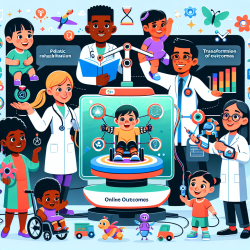Introduction
In the rapidly evolving field of speech-language pathology, digital phenotyping offers a promising avenue for enhancing clinical outcomes. The research article titled "Requirements and Operational Guidelines for Secure and Sustainable Digital Phenotyping: Design and Development Study" provides valuable insights into creating secure and sustainable platforms for behavioral monitoring. This blog aims to help practitioners improve their skills by implementing the research outcomes and encouraging further exploration in this domain.
Understanding Digital Phenotyping
Digital phenotyping involves the collection and analysis of data from personal devices, such as smartphones and wearables, to capture human behavior in real-time. This innovative approach provides a detailed perspective on behavior, with the potential to revolutionize both research and clinical practices. However, the rapid development of this field necessitates a focus on the security and sustainability of the platforms used.
Key Findings from the Research
The study highlights several requirements and operational guidelines essential for developing secure and sustainable digital phenotyping platforms:
- Security Measures: Implementing data isolation, encryption, and a robust organizational security culture are critical to protecting sensitive data.
- Sustainability: Ensuring the maintainability, reliability, and scalability of software products is crucial for long-term success.
- Data Management: Employing a structured data flow, from collection to analysis, enhances the efficiency and security of data handling.
Practical Implications for Practitioners
For practitioners in speech-language pathology, integrating digital phenotyping into clinical practice can offer numerous benefits:
- Enhanced Data Collection: Utilize smartphone-based applications to gather real-time behavioral data, providing a more comprehensive understanding of a child's communication patterns.
- Improved Clinical Outcomes: Leverage the detailed insights gained from digital phenotyping to tailor interventions more effectively, thereby improving patient outcomes.
- Data-Driven Decisions: Use the quantitative data collected to make informed, evidence-based decisions in treatment planning and evaluation.
Encouraging Further Research
While the current research provides a solid foundation, there is ample opportunity for further exploration in this field. Practitioners are encouraged to engage in ongoing research to refine digital phenotyping techniques and explore new applications in clinical settings. Collaboration with technology developers and researchers can lead to the creation of more advanced and user-friendly platforms.
Conclusion
Digital phenotyping represents a significant advancement in the field of speech-language pathology, offering new tools for enhancing clinical practice. By implementing the guidelines from the research, practitioners can improve their skills and contribute to the development of secure and sustainable platforms. For those interested in delving deeper into the study, the original research paper can be accessed here.










